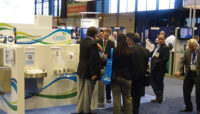In Missouri, we get our share of cold weather. It wasn't long ago that nature had us in her icy grasp--snow and ice and sleet, oh my! But we made it to the end of our yellow brick driveway with a little help. . .from radiant heat!
Snowmelting employs tubing buried outside to melt ice and snow, keeping driveways, sidewalks, hospital and senior housing entry areas, helicopter pads, and delivery ramps free of ice and snow. Radiant heat performs a valuable, perhaps life-saving function.
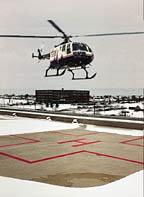
Why Snowmelt?
Snowmelting has several benefits. Icy surfaces are no longer a concern. And facility maintenance costs are reduced because ice-melting chemicals that kill landscaping, increase building cleanup, and degrade concrete and asphalt aren't required. Labor costs fall sharply when parking lots and driveways don't have to be shoveled and plowed.
Snowmelts don't cost money; they save it! The cost of the system is more than returned with one avoided legal action. Insurers recognize the value of these systems, rewarding building owners with reduced insurance rates.
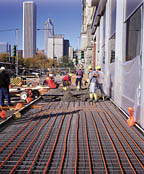
Snowmelting Classifications
Snowmelts are grouped according to the amount of snow a system can melt. There are two systems of classification--old ASHRAE (American Society of Heating, Refrigeration, and Air-conditioning Engineers) and new ASHRAE.Old ASHRAE
Old ASHRAE classifications split systems into three groups that center around the amount of snow melted at design conditions:
- Class I--designed not to melt snow while it is falling, but afterwards;
- Class II--half the snow is melted while falling, the rest afterwards; and
- Class III--all snow and ice is melted while falling.
Design conditions are the key to these classifications. If a system is designed as a Class I for heavy snowfall, it would perform as a Class III system with minor snowfall. Conversely, a Class III system designed for minor snowfall would perform as a Class I system with heavy snowfall.
New ASHRAE
The New ASHRAE standard still keeps three divisions, but names them "snow free ratio," represented by 0, 0.5 and 1. The standard also adds a percentage to alleviate the problem of "over-design" by defining the percentage of time the snowfall amount is less than designed. The snowfall percentages are 75%, 90%, 95%, 98%, 99% and 100%, with 100% being the maximum snowfall for an area.Snowmelting Loads
Generally, it takes about five to six times more energy to melt snow than to heat a building. It usually takes 30 to 40 Btu/hr/square foot to radiantly heat a structure. However, it takes 150 Btu/hr/square foot or more to melt snow and ice. To understand why, let's look at the components of the load.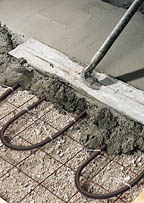
Components of Loads
Losses to groundWhen starting a system, there's a loss of energy from the tubing to the surroundings. A snowmelt usually starts when the surroundings are frozen. Energy from the tubing doesn't necessarily rise. Rather, it travels in any direction, from hot to cold, seeking equilibrium.
This loss, however, is minor when compared to other snowmelting loads. The loss to the ground is only 10-15 Btu/hr/square foot, or 1/10th the total energy required. Because the loss is relatively low, and vehicular traffic relatively high, insulation underneath the system is rarely recommended. Insulation is usually only required to protect plantings that go dormant next to the snowmelt.
Warming snow from 0 degrees F to 32 degrees F
As many know, the Btu, or British Thermal Unit, is the amount of energy required to increase one pound of water 1 degrees F. In snowmelting, ice or snow at ambient temperature has to be raised to 32 degrees F so it can melt. The colder the temperature, the more energy is required to heat ice or snow to 32 degrees F, but less water is contained in it. The warmer the temperature, the less energy is required to warm the ice or snow to 32 degrees F, but more water is contained in it.
The energy required for raising snow and ice from ambient temperature to 32 degrees F is 10-30 Btu/lb. One pound of water is about a quarter-inch per square foot of ice or a half-inch per square foot of 32 degrees F snow.
Changing snow or ice at 32 degrees F to water at 32 degrees F
For water to go from solid to liquid, we must add energy. The latent heat of vaporization is adding energy to 32 degrees F ice and snow to get 32 degrees F water. This energy is always 144 Btu/lb.
Warming water from 32 degrees F to 35 degrees F
Once at 32 degrees F liquid, we must ensure that water stays liquid. We increase the temperature of the water to 35 degrees F. This added energy is minimal when compared to other loads, but must be accounted for at 3 Btu/pound.
Atmospheric losses
Once snow starts melting, energy will be lost to the atmosphere. The atmosphere will literally "suck" up to 100 Btu/hr/square foot from the slab.
Losses down the drain
As snow changes to water, it drains into storm sewers, ditches and the landscape, carrying energy from our slab. Be certain the water runoff has somewhere to go; otherwise it will pool and freeze, creating ice dams and stopping further drainage. Sometimes drain pipes and ditches are snowmelted also.
Evaporation
The change from a solid or liquid to a gas as snow evaporates uses energy from our snowmelt system. This energy must be replaced by the heat source. The amount of energy lost depends on the surroundings.
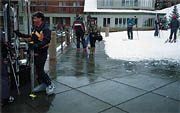
Snowmelt Examples
Snowmelts bury tubing in a concrete slab. The most popular tubing is either cross-linked polyethylene (PEX) or synthetic rubber (EPDM). PEX is high-density polyethylene (HDPE) that's "cross-linked" into longer, stronger molecules. EPDM rubber is made from synthetic rubbers, also "cross-linked." Both tubes have a long history of durability and longevity in snowmelt applications.Tubing is between 1? ID (inside diameter) and 3? ID. The tubing is connected to supply and return piping with copper, brass, stainless or plastic barbed manifold pairs. The type of barb must match the type of tubing and recommended connection. Manifold placement dictates where the tubing starts and stops. These manifolds are typically located together next to the "zone," or snowmelt area. If the manifolds are located away from the zone, more tubing is required. Manifold placement dictates the maximum length of tubing required, thus dictating the ID, since the longer the required length, the larger the required ID, reducing pumping friction losses.
Tube spacing is varied from 6-12 inches on center according to the requirement of snow or ice melting. More snowfall melted at a faster rate will require closer tubing spacing.
Between 110 degrees and 140 degrees F water-glycol mixture is pumped through the tubes. More material over the tubing increases heat transfer resistance, requiring a higher water temperature. Between 30% and 70% glycol is used, depending on freeze protection required.
The tubing is installed strapped or tied to rebar or rewire, hooked to the base material with turf hooks, or snapped into plastic guide tracks nailed into a compacted base. It is important to maintain the recommended spacing and keep the tubing from floating to the surface of the concrete pour. A minimum of 2-3 inches of covering must be maintained over the tubing to prevent concrete cracking.
A boiler or heat exchanger heats the water-glycol mixture. Dedicated water heaters seldom have enough capacity to sustain a snowmelt energy requirement. Controls turn the system pumps and heat source on and off.
Brick paver snowmelts--Brick pavers are well suited to snowmelt. Though durable, they're destroyed when exposed to snow- and ice-removing chemicals. They are also tough to clear by shovel or blade.
With a brick paver snowmelt, tubing is buried in the base with at least two inches covering the tubing. Tubing is spaced nine inches on center. The supply water temperature is 130 degrees to 160 degrees F, higher than normal due to more material over the hose.
Asphalt snowmelts--Asphalt is a difficult material to snowmelt and isn't widely recommended. The high temperatures of the applied asphalt, combined with a resistance usually twice that of concrete, and the later complication of what happens when a second or third layer is required makes this a poor choice for snowmelt.
Helipads--Hospital helipads make excellent snowmelts. With space increasingly valuable, hospitals are forced to install helipads on building roofs. These can become dangerous when covered with ice and snow. Snowmelts keep helipads snow- and ice-free.
Helipad snowmelts are installed in concrete or extruded aluminum. Tubing is installed six inches on center. In concrete, there must be three inches over the hose. With aluminum, the tubing is installed so it contacts the upper surface.
Sidewalks and entrance ramps--More inviting to customers and more convenient to employees, sidewalk snowmelts can increase traffic and safety, while decreasing liability.
Sidewalk systems are installed six to nine inches on center for faster response than driveways installed 12 inches OC. The tubing must at least be two inches from the top surface.
Stairs--Stairs are often slippery and dangerous, especially when covered with ice or snow.
They vary by application, but are installed with at least two lengths of tubing in the tread and sometimes one length in the riser. Stair treads are 10 inches or wider, thus translating to five-inch on center tubing spacing. For wider treads, spacing wider than six inches OC is not recommended. Tubing must be at least two inches from the top of the tread and two inches from the face of the riser, and close to the nose of the stair.
Car washes--Using snowmelt, car washing facilities can be kept ice-free.
Tubing is installed in concrete at 12" OC to keep the slab warmer than 35 degrees F. A 10-foot entrance and exit area also has tubing installed to melt snow and keep the surfaces ice-free as wet cars drive across them. The spacing of the entrance and exit areas is 9" OC. For car washes, either air or slab temperature is monitored. If the temperature of either falls below 35 degrees F, the system turns on. When the temperature rises above 35 degrees F, the system turns off.
Hospital entrances--Hospital entrances are spaced six inches OC to keep the surface free of ice and snow. These systems are "idled"--operated continuously at reduced output--to decrease system lag--the time the system requires to reach operating temperature and melt snow. When the sensor detects precipitation, the system is operated at full output.
Parking garage ramps--Snowmelting ensures cars driving from the street can safely negotiate parking garage ramps.
Spacing varies between 9" OC and 12" OC, depending on roof coverage over the ramp. More coverage equals less output needed, and wider spacing can be used. One cautionary note: be sure to place sensors for these controls (away from the ramp) where they can detect precipitation and temperature.
Loading docks--"Moving the goods" is the motto of many shipping companies. Snowmelts ensure the goods are moving around your facility because trucks can easily get to the loading docks.
Loading dock snowmelts are spaced at 12" OC. These areas are not considered critical; some snow can be allowed to collect on the surface.
Large area "hot pads"--Snow mounds occupy space and create dangerous runoff. Instead of melting an entire runway or parking lot, often too large and costly, smaller areas are heated to melt piles of stashed snow.
Tubing for hot pads is spaced 4-6" OC to melt large amounts of snow and ice. Snow from runways or parking lots is collected and dumped on the pad. It's common to see 30' by 30' hot pads piled 4-6 feet high! Hot pads are operated manually. Twist timers or switches are used.
Principles of Operation
On-Off OperationSome snowmelts are only operated when precipitation is present below 35-38 degrees F. While cheaper to operate, these systems take longer to melt ice and snow since they have to increase the slab temperature first. Controls--Simple, low-cost controls automatically start a system when precipitation is present below 35 degrees to 38 degrees F. The control continues operating the system for 4-6 hours after precipitation has stopped, ensuring the surface is clear. Twist timers allow manual override of the system controls. When winter storms approach, the system is started several hours beforehand, with the twist timer reducing system lag time. If snow drifts on the snowmelt but does not engage the precipitation sensor, the system can be manually started.
Idled Systems
To reduce system response time, they are idled--operated at reduced output--until required, when they operate at full output. Idling systems are required when the surface must be kept free from ice and snow. Controls--Sophisticated controls sensing slab temperatures, outdoor temperatures, system operating temperatures, and precipitation are used. These are more expensive than on-off controls, but allow for much greater system flexibility. They have settings for warm-weather shutdown, slab idle temperature, and cold-weather shutdown, necessary because snowmelt systems are not effective below about -10 degrees F. The heat source cannot provide enough energy below -10 degrees F for snowmelting--rarely troublesome since snow below 0 degrees F contains very little water.
Operating Cost
Snowmelts are not expensive to operate, since they only operate a few times each year. The biggest cost of a snowmelt system is the initial system cost. Antifreeze is required, since the system is either dormant or could go dormant during freezing weather. Pumps are required to move the water-glycol mixture. Boilers are required to deliver 100-300 Btu/hr/sq. ft.Supply and return piping is needed to move the energy from the boiler to the manifolds for the tubing buried in the slab. Complete systems can cost between $6-$12 per square foot installed.
On-off
The cheapest system operationally is an on-off snowmelt. They are only used 5 or 10 times per year. For example, a Class II system in Buffalo, NY, only costs about $0.21 per square foot per year to operate. In Chicago, IL, it would cost $0.12 per square foot per year. In Minneapolis or St. Paul, it would cost $0.25 per square foot per year.
Idled systems
Idled systems, operating any time the temperature is below 35 degrees to 38 degrees F, cost more to operate. When idling 3,000 or more hours per year, a system consumes up to 125 Btu/hr/sq. ft. Hospitals or other facilities may have waste heat from steam or condensate readily available, greatly reducing system-operating costs.
So, whether you're seeing an occasional need to eliminate snow in Springfield, or warming an emergency room entrance in Nome, a snowmelt system, properly installed, will readily answer the call.
